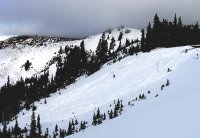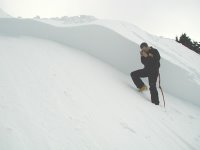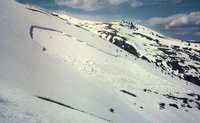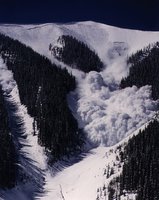 | National Park Service Olympic National Park Newsletter, Avalanche scar on north-facing slope just north of Hurricane Ridge parking area |
 | National Park Service Olympic National Park Newsletter, Olympic Mountain Rescue volunteer investigates avalanche face shortly after the slide. |
Wet avalanche, Definition: A flow of snow, ice, rock, and other material that occurs as a result of thawing. Context: These occur mostly late in the snow season when the snowpack is deep and the thaw is just beginning.
Ice Avalanche, Definition: Falling blocks of ice create an avalanche, which often entrains snow below it or triggers slabs. Context: Glaciers flowing over cliffs form icefalls and most common in big mountains.
Glide Avalanche, Definition: A type of wet avalanche, they occur when the entire snowpack slowly slides as a unit on the ground (similar to a glacier). Context: Glide avalanches are a slow process which usually occur over several days, weeks or even months. Caused by melt water libricating the ground and allowing the overlying snowpack to slowly "glide" downhill.
Slush Avalanche, Definition: A sluch avalanche occurs when a cold dry snowpack suddenly becomes saturated with water. It then catastrophically looses strength and the resulting slush often runs long distances on gentle terrain. Context: Common in northern latitudes such as Alaska and other high latitiude permafrost regions.
Text and Photo Credit: National Park Service - Information presented on this website, unless otherwise indicated , is considered in the public domain. It may may be distributed or copied as is permitted by the law.
Avalanches, Much of the terrain in the Olympics is prone to avalanches and should be avoided until avalanche danger lessens. Avalanche hazards may exist through out the winter, spring and early summer in some areas.
Don't let the next avalanche victim be you or someone you know!
Avalanche Tips, All winter travelers should be familiar with the terrain they will be traveling in and should be familiar with avalanche self-rescue techniques. Remember, the most important factor is prevention -- the probability of rescuing someone who has been buried in an avalanche is low.
Do not travel alone in Avalanche Country! Avalanche release zones may be well above you and not within your sight. Do not travel below steep open slopes, especially where avalanches have already occurred and during warming periods or times of heavy rain or snowfall.
The most dangerous time for avalanches is during heavy snowfall (rates of one inch or more per hour) and warming periods with heavy rains or sunshine. When planning or leading a trip into the mountains, examine your destination and EVERY STEP OF THE ROUTE to see whether or not the terrain and conditions pose a threat. Be especially vigilant if the temperature rises significantly or suddenly by 4-10 degrees, if steady rain falls on the snowpack, or if bright sunlight shines directly on exposed slopes.
Avoid climbing or traversing suspect slopes or traveling along valley bottoms beneath such slopes. Ridge-tops are much safer; but watch out for huge cornices overhanging leeward sides.
Special dangers: 1) steep north, east or lee faces; 2) south slopes at midday; 3) warmer than usual weather.
If there is any doubt, cancel the trip or reschedule your route or destination to a safer location with gentle, forested slopes and little snowpack. Use good avalanche practices of never raveling alone, and spacing party members some distance apart in questionable spots.
Carry and know how to use avalanche transceivers, but do not rely on them to keep you from danger. If you are a member of a party led by someone you don't know or if you have questions or doubts about their judgment, ask questions. Do not assume they are competent.
More Information, Avalanche conditions may exist throughout the spring and well into the summer months in some areas. Before your trip, find out snow conditions in the area you plan to travel.
For more information on snow conditions, route information and snowpack analysis contact: The Wilderness Information Center (360) 565-3100
Source: National Park Service Olympic National Park Avalanche Hazards
Information presented on this website, unless otherwise indicated , is considered in the public domain. It may may be distributed or copied as is permitted by the law. NPS disclaimer
Generally speaking, works created by U.S. Government employees are not eligible for copyright protection in the United States. See Circular 1 "COPYRIGHT BASICS" from the U.S. Copyright Office.
Anyone incorporating a work of the U.S. Government into a copyrighted work should be aware of 17 U.S.C. § 403. This section requires a copyright notice to contain a statement identifying what portions of the work consist of a work of the U.S.Government.
Leave a comment, make a request, Let this small sampling be a guide to better quality, more plentiful, public domain, royalty free, copyright free, high resolution, images, stock photos, jpeg, jpg, free for commercial use, clip art, clipart, clip-art. more at Public Domain Clip Art and clip art or public domain and Weather or Avalanche and National Park Service or NPS and snow

















No comments:
Post a Comment